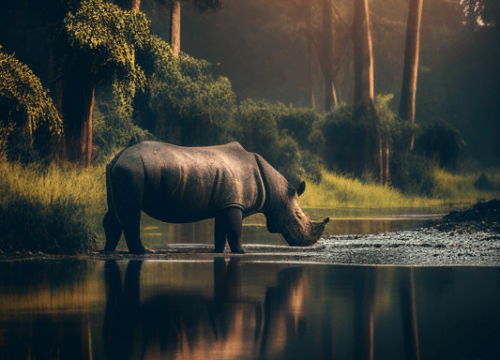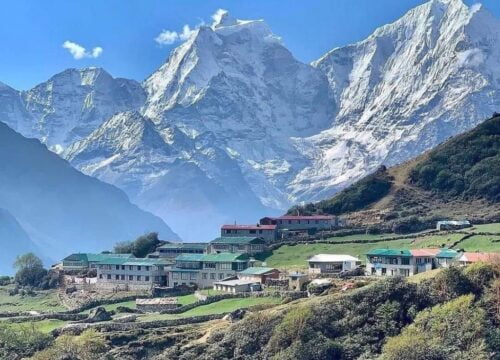Tsum Valley Trek
Trip Overview
Hidden Treasures Unveiled
Nestled in the northern reaches of the Gorkha province lies the mystical Tsum Valley, a Himalayan gem that remained concealed from the outside world until 2007. This remote pilgrimage site, shrouded in an aura of mystery, beckons adventurers and culture enthusiasts alike to explore its serene landscapes and ancient villages.
Preserving Timeless Traditions
Tsum Valley stands as a bastion of traditional Tibetan culture, steadfastly preserved despite the passage of time. Shielded from the influences of modern development by its isolation, the valley’s inhabitants continue to uphold age-old customs, language, and social structures. Notably, the practice of polyandry among Tsum Valley women endures, serving as a poignant testament to the resilience of their heritage.
A Cultural Tapestry
Walking through the quaint villages of Tsum Valley is akin to stepping into a living museum of Himalayan culture. Amidst the rugged terrain, a rich tapestry of traditions is interwoven into everyday life. Vibrant festivities such as Lhosar and Dhacyhang punctuate the calendar, offering visitors a glimpse into a world where ancient rituals and modernity harmoniously coexist.
The Majestic Himalayan Backdrop
The valley finds itself cradled by the towering peaks of the Ganesh and Sringi Himalayas, a majestic backdrop that adds to its allure. As trekkers venture forth into this pristine wilderness, they are greeted by snow-capped summits that inspire awe and introspection. Each step taken amidst the tranquil valley below serves as a reminder of the raw power and timeless beauty of the Himalayan landscape.
An Odyssey of Discovery
Trekking through Tsum Valley transcends mere physical exertion; it becomes a spiritual odyssey, unveiling the secrets of a bygone era. Every encounter with the locals, every flutter of prayer flags in the wind, and every vista of towering peaks serves to deepen one’s connection to the valley and its inhabitants.
Timeless Reconnection
In Tsum Valley, time seems to stand still, offering visitors a rare opportunity to reconnect with nature and themselves. Amidst the ancient traditions and breathtaking landscapes, a sense of peace and tranquility prevails, allowing for moments of introspection and renewal amidst the majesty of the Himalayas.
Trip Itinerary
A representative of Adventure Glacier Treks will meet you at the arrival gate of Tribhuvan International Airport (TIA), Kathmandu. And you will be transferred to a hotel, after which there will be a briefing about the necessary procedures, the climbing route, and your climbing permit. Depending on your arrival time, you can spend your free time visiting nearby temples or taking a break.
We will analyze the gear you need for the treks and, if we have any, recommend that you buy, rent, or receive it from us. The Kathmandu Valley may be explored in a single day. If you'd like, we may arrange for a tour guide to assist you as you tour Kathmandu (it costs extra).
Today we will drive to Arughat by bus and it will take 8 to 9 hrs hours to reach Machha Khola. The drive is long and scenic, with views of Nepal's green hills, curvy roads, and fast-flowing rivers.
Today's journey will be up and down, through sand river flats, with opportunities to spot monkeys and langurs in the jungle. Smaller Khorlabesi was mostly destroyed by a massive rock slide years ago, but a survivor has established a botanic garden. The large Gurung villages are further up the journey passing a few houses. After hiking over a ridge and the Buri Gandaki on a suspension bridge, on marble stairs in the restricted valley of Doban, we finally arrive at Tatopani the Natural Hot Spring (930m) (1,000m). and then to Jagat (1,410m), a charming Gurung settlement made of stonework, from Yaru Khola (1,363m). where the permit checkpoint is located. six-hour trek.
To get to Sirdibas (1,430 m), the first Buddhist town on this walk, we will go along the riverbank, cross a steep ridge at Salleri (1,440 m), where we will get spectacular views of Sringi Himal (7,187 m), and then descend. Before crossing Nepal's largest suspension bridge and continuing uphill to the Gurung village of Philim (1,590 m), we will be trekking upriver through fields of millet, millet, and potato as well as blue pine, poplar, and oak forest. A large region of pine trees can be reached after hiking for about an hour through Ekle Bhatti (1,600 m), then ascending above the Marvelous Gorge. It will take around 6 hrs to reach Lokpa.
Today's hike will include the most challenging hills and steps, but it will be delightful as we stroll through a lovely mixed forest, listening to the sounds of birds, a river, and a soft wind. We typically have to cross the footbridge to reach Chumling. Although it's a little more difficult, the trek is shorter than our usual one. Visit the old gompa (Tibetan monastery), the traditional homes, and the lovely stone streets while walking through Chumling. There is a 4-hour hike from Lokpa to Chumling.
We begin our tour today by going through fertile farmland that is surrounded by high stone walls that keep out animals. Beautiful, authentic-looking Tibetan classic homes with stone arched gates, mani walls, and fuel bundles on the roofs. With long suspension bridges on the opposite bank, far above the village of Ripchet (2,468 m), the hike across the Serpu Khola takes us to Upper Tsum and the sizable village of Chhokangparo. You can enjoy great views of the 7,422-meter Ganesh Himal while trekking across the big slip that is now covered in a forest (3,010 m).
The path winds through small villages and ascends reflecting growing cliffs through plain fields. We go to Milarepa's Cave, where we can see Milarepa's footprint and where the Buddha's bringer to Tibet is said to have meditated. We'll walk across Shiar Khola. Nile and Chule, two villages on opposite sides of Shiar Khola, are home to the oldest Buddhist monasteries. The chortens are fantastic and very authentic, and today is probably one of the best days on our trek for seeing a lot of beautiful scenery. (7-hour journey)
Trekking downhill from Mu Gumpa to visit Rachen Gompa nunnery, the female equivalent of Kathmandu's main Kopan Monastery, with its massive courtyard. From where you walked two days ago, you probably have the best views of Tsum valley.
Walking back to Chhokangparo, via the previously traveled route for two hours until reaching the little gompa at Gho (2,485 m), and then walking down to the Shiar Khola, and over to Dumje, a community of eight dispersed dwellings and a school and clinic for Tibetan herbal medicine. Trekking steeply up from Dumje through stunning forests of massive silver pines and rhododendrons The Gumba Lungdang (3,200 m), likely the valley's oldest monastery, is located on a ridge with breathtaking views. There are 40 monks living in this gompa, and every evening from 6 to 7:30 is a very important time for puja.
Downhill trek from Gumpa Lungdang to Dumje, then to the scenic view. It's a lovely, remote village with fertile land for growing crops and raising animals. The area is perfectly created by the evocative chortens and mani walls in the fields, as well as the pine forest backdrop. The journey takes to reach Lokpa Village.
Trekking down several steep stairs to the river at Ghumlong (2,130m), which we had already covered a few days earlier, and then on to Lokpa, Jagat, and Dobhan.
Trek back on the same trails but from different angles, taking pictures as you go downhill, and covering the entire valley in about 7 hours.







